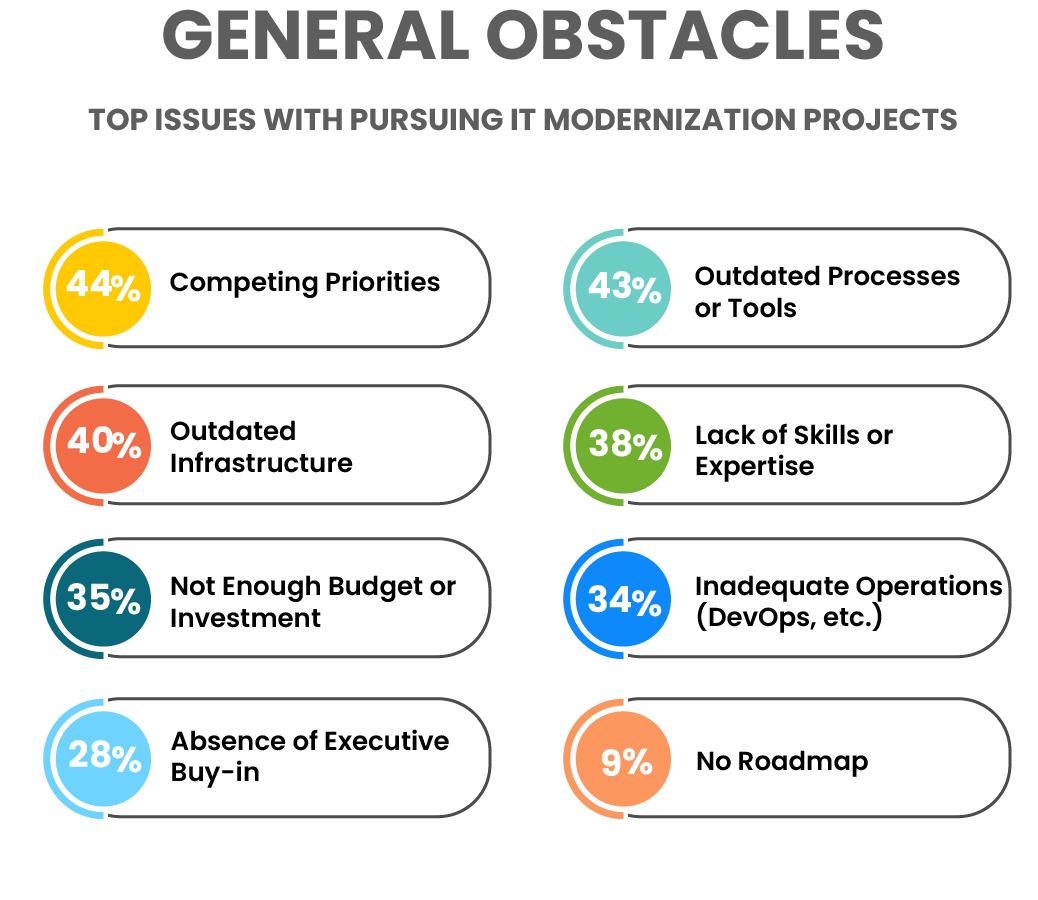Cloud Infrastructure Modernization: A Path to Agility and Innovation
Publish Date: August 22, 2023Cloud modernization encompasses modernizing infrastructure, applications, and data, leading to cost savings and securing a company’s future. It benefits organizations at any stage of their journey, enabling them to utilize the inherent agility and innovation of Cloud services. Modernized infrastructure allows businesses to efficiently adapt to market changes, reduce operational overhead, and focus on core competencies.
Public cloud services are crucial in this transformation, as by 2025, 51% of IT spending on application and infrastructure software, business process services, and system infrastructure is expected to shift to the public cloud, up from 41% in 2022. By 2025 approximately 65.9% of application software spending will target cloud technologies, compared to 57.7% in 2022, while Cloud system infrastructure services spending is projected to grow from $1.3 trillion to almost $1.8 trillion in 2025, as per the latest Gartner forecast. This shift to the public cloud empowers global companies to swiftly extract business value from data and meet unpredictable user demands. [1]
Cloud infrastructure modernization refers to updating and optimizing an organization’s IT infrastructure by migrating it to cloud-based technologies and services. This transformation aims to improve the organization’s computing resources’ efficiency, scalability, flexibility, and security.
Critical aspects of cloud infrastructure modernization may include:
- Cloud Service Migration: The process of transferring applications, data, and workloads from traditional on-premises data centers or legacy systems to cloud service providers such as Amazon Web Services (AWS), Microsoft Azure, Google Cloud Platform (GCP), and others
- Scalability and Flexibility: By utilizing cloud resources, businesses can easily adjust their scale and capacity according to fluctuating user traffic and workload demands. This scalability and flexibility enable quick adaptation to changing requirements.
- Containerization and Orchestration: Embracing container technologies such as Docker and utilizing container orchestration platforms like Kubernetes enhances the deployment and management of applications. This adoption facilitates faster development cycles and optimizes resource utilization, improving efficiency and productivity.
- Microservices Architecture: Restructuring applications into more minor, self-contained services that can be developed, deployed, and scaled independently. This approach boosts flexibility, maintainability, and resilience, improving overall performance and adaptability.
- Serverless Computing: Leveraging serverless technologies enables running applications without the requirement of managing the underlying infrastructure. This empowers developers to concentrate solely on coding, eliminating the burden of operational tasks and reducing overhead responsibilities.
- Automated Infrastructure Management: By adopting infrastructure as code (IaC) practices, organizations can automate the provisioning, configuration, and management of cloud resources. This approach ensures consistent and repeatable deployments, streamlining the process and reducing potential errors or inconsistencies.
- Data Management and Analytics: By utilizing cloud-based databases and analytics services, organizations can enhance data storage, processing, and analysis capabilities. This empowers data-driven decision-making by providing efficient and scalable solutions for managing and extracting insights from large volumes of data.
- Security and Compliance: Deploying robust security protocols, implementing identity and access management (IAM) systems, utilizing encryption methods, and adhering to compliance frameworks are essential to safeguard data and ensure compliance with industry-specific regulations.
- Cost Optimization: Employing cost management tools and implementing best practices provided by cloud providers to optimize expenditures and prevent unnecessary expenses.
- Monitoring and Performance Management: Employing monitoring and performance management solutions specifically designed for cloud environments to guarantee peak performance and uninterrupted availability of cloud resources.
- Disaster Recovery and Business Continuity: By utilizing cloud-based backup and disaster recovery solutions, businesses can ensure the resilience of their data and achieve rapid recovery in the event of unforeseen outages or data loss incidents.
However, many enterprises need help with modernizing their cloud infrastructure. Let’s explore some obstacles they face and discover the best approaches/effective strategies to overcome them.

Best Approaches/effective strategies:
- Thorough Assessment: Before embarking on infrastructure, application, and process modernization, conducting a comprehensive assessment is crucial. This enables the identification of challenges, risks, and opportunities, leading to a smoother migration process.
- Select the Right Cloud Platform: Choose the right cloud service provider that aligns with your organization’s needs and requirements. Consider factors like available services, global reach, pricing, and support.
- Automation Tools: Minimize the risk of human error during migration by leveraging automation tools. These tools can handle performance monitoring, application configuration, and resource provisioning, streamlining the process.
- Implementing Robust Security Practices: Security should be a top priority during cloud modernization. Safeguard your cloud-based applications and data using best-in-class security practices. Data encryption, secure authentication mechanisms, and network security and monitoring for potential threats bolster information protection.
- Continual Optimization: Regularly monitor and optimize the cloud environment to ensure optimal performance, cost savings, and heightened security. Identifying areas for improvement and implementing changes in a well-planned sequence is vital for sustained success.
- Gradual Rollout and Monitoring with Thorough Testing and Validation: Adopt an incremental rollout strategy accompanied by meticulous testing and validation to overcome the challenges while modernizing cloud infrastructure. Gradually introducing the changes minimizes disruptions, leading to a seamless transition.
- Adopt DevOps Practices: By incorporating DevOps principles into the modernization strategy, organizations can enable continuous integration, continuous delivery (CI/CD), and automation. This approach streamlines the deployment process, allowing faster releases while fostering collaboration and coordination.
- Leverage Infrastructure as Code (IaC): Employing Infrastructure as Code (IaC) tools allows for the automated definition and provisioning of cloud resources. This approach guarantees consistency, minimizes manual errors, and enables effective version control for managing infrastructure changes.
What are the benefits of the Cloud Modernization Strategy?
Cloud modernization strategy fosters improved efficiency, heightened security measures, and cost reduction. By modernizing applications and data, businesses can enjoy enhanced accessibility, scalability, and reliability. Cloud infrastructure modernization can help you:
- Relieve cost pressures: Modernizing with the cloud eliminates the need for maintaining on-premises hardware and infrastructure, resulting in cost savings. Pay-per-use basis allows businesses to pay only for the services they need, reducing unnecessary expenses associated with unused resources.
- Agility: Cloud solutions facilitate market entry for new products and services. Businesses can rapidly use various pre-built tools and services to develop and deploy applications across multiple devices.
- Robust Security: Cloud providers invest significantly in security, ensuring faster data and application protection. They offer various security services, including identity and access management, encryption, and network security. Some providers even support Multi-factor authentication for an extra layer of protection.
- Elasticity: Cloud infrastructure can automatically adjust resources based on workload demands. This elasticity allows organizations to handle sudden spikes in traffic without service degradation.
- Innovation and Access to New Services: Cloud providers continuously introduce new services and features. Organizations can use these innovations without extensive re-architecting by modernizing their infrastructure.
- Collaboration and Remote Work: Cloud-based applications and services facilitate collaboration among teams, regardless of their physical location. This is especially valuable in a remote work environment.
- Data Analytics and Insights: Cloud platforms provide robust data analytics tools, enabling organizations to gain valuable insights from their data, leading to better decision-making and improved business strategies.
- DevOps Enablement: Cloud modernization often goes hand-in-hand with DevOps practices, fostering a culture of collaboration between development and operations teams, resulting in more efficient and reliable application delivery.
Overall, a well-executed cloud modernization strategy empowers organizations to innovate faster, reduce operational overhead, focus on core competencies, and stay ahead in a rapidly changing market.
How YASH Technologies accelerates cloud infrastructure modernization
At YASH Technologies, we recognize that cloud modernization goes beyond mere technology adoption. It entails a comprehensive data and application mapping strategy aligned with your business goals and IT environment while considering talent capabilities and gaps. Leveraging almost three decades of experience in public cloud, private cloud, and SaaS, we can guide you in reaping the rewards of cloud modernization and maximizing the benefits of your technology investments as you embrace rapid evolution.
With a customer-first, cloud-first approach, we facilitate continuous modernization across multi-cloud, data, apps, and security, utilizing cutting-edge technologies managed and optimized on the right platform to achieve the best business outcomes for our clients. This leads to cost reduction, improved customer experiences, and accelerated innovation, enabling you to stand out in the market.
YASH plays a crucial role in accelerating cloud infrastructure modernization for organizations. YASH offers extensive services, tools, and expertise to expedite migration and optimization. Here are some ways in which YASH accelerates cloud infrastructure modernization:
- Robust Cloud Platform Services
- Cloud Infrastructure Managed Services
- Migration Tools and Frameworks
- Expertise and Support
- Infrastructure as Code (IaC)
- Global Reach and Availability
- Security and Compliance
- Continuous Innovation
- Ecosystem of Partners
- Pay-as-you-go Model
- Training and Certifications
Our certified technical experts offer a wide range of cloud modernization services tailored to your infrastructure, application, and data portfolio, meeting you at any stage of your modernization journey. To know more, connect with us at info@yash.com.




